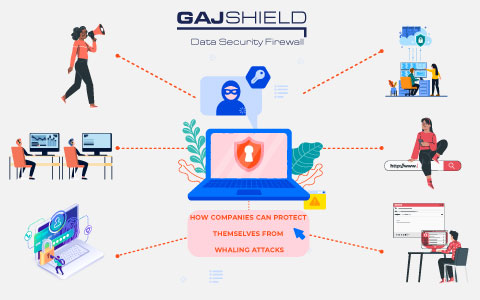How Companies Can Protect Themselves From Whaling Attacks
It is no secret that cybercriminal attacks are getting increasingly superior with every passing day. The attacks aim to extract confidential information and make profits. Criminals behind such attacks target anyone, from individuals to high-value companies. One attack, however, is made to attack CEOs or high-profile individuals. This is called a whaling attack. The reason for its name signifies the magnitude of the attack, in which the company is caught in a web where they are defenceless, just like it is in fishing. The main goal of the attack is to trick high-level employees into authorizing a large sum of money or disclosing personal information to the criminal. This attack is initiated through social engineering, content spoofing, and email spoofing.
Whaling attacks start with the cybercriminal creating customized websites and emails and feeding them with enough relevant information gained from different sources to trick the individual into believing it is from a trusted source. Due to the in-depth research conducted on high net-worth employees, the work created by the attackers is so nuanced that it makes detecting the attack difficult. Certain measures need to be enforced to ensure the data security of high-profile employees and the company they are associated with.

How to Defend Against Whaling Attacks
To combat whaling attacks, companies must proactively take measures to protect their data security. They can do so by:
1. Developing Employee Awareness
The first step to protecting an organization against cyber attacks or threats is to train, educate and develop the entire workforce's responsibility to protect the company’s assets. In the case of a whaling attack, such awareness should not be limited to the high-level executives but the entire workforce. Everyone should be highly trained in identifying any vulnerability surrounding the company’s data security. Even though the main target in a whaling attack is higher management, cybercriminals can also be tricked to expose the executives through an error in threat detection indirectly. Social engineering tactics, like sending false alarms or threats, fake email addresses masking a trusted one, requests for urgent responses, and more, are some of the things employees should be on the lookout for.
2. Integrating OPSEC
OPSEC, or Operations Security, is a strategy to classify and secure data by reducing the ways to access confidential information that bad actors require to extract and make profits using whaling attacks. Implementation of this strategy not only reduces the attack force but also continuously monitors to check for any vulnerabilities or threats in the company’s network. There are times when the attacker can penetrate through the defence wall, OPSEC will then rapidly deploy countermeasures to mitigate the damage through a disaster recovery plan. The optimal method of ensuring a stringent practice for data security is to identify and understand any security gaps.
3. Encrypting Data
Another way of data security is to encrypt all sensitive files and information to minimize threats or attacks from cybercriminals. Encryption makes confidential data illegible and will only make sense if the person accessing encrypted data has the decryption code. If the high net-worth individual does get tricked into a whaling attack and transfers the file, without the decryption code, the attacker won’t be able to access it.
4. Employing Zero Trust
An essential step toward data security is to employ zero trust in the entire organization’s system. This security model considers every access request a threat, and only after complete and thorough verification will it grant access. Therefore, any requests for access to confidential information or wiring of money to accounts should be considered suspicious and require authentication at every stage and only then be granted authorization.
5. Using DMARC Technology
DMARC, or Domain-based Message Authentication, Reporting, and Conformance, is a standard security technology that helps companies evaluate and verify emails. It helps protect the user from email phishing or poofing, a common step taken for a whaling attack.
6. Monitoring of Security Vendors
An organization has no control over the security protocols taken by the third-party security vendor. Therefore, if they are under attack, their vulnerability could significantly impact the security network of the organization, and the attacker will get access to extract all confidential information. Companies should regularly monitor and recheck any emails they may receive from them.
In this day and age, where cyber threats are getting more advanced, the tools to counter them need to advance at an equal pace, if not faster. A whaling attack is a vast attack in which high-profile employees of a company are deceived into releasing sensitive information or wiring a large sum of money through email phishing or spoofing as they possess access to sensitive data. Organizations need to prevent these attacks as they could disrupt the reputation of the individual and the company associated with them. Employee awareness and stringent security protocols and tools must be employed to secure data from attacks. In case of a breach, a disaster recovery plan should be initiated to maximize damage control.
GajShield provides powerful cybersecurity solutions to mitigate any threats or attacks. By providing users with email security, URL filtering, threat surface management, a zero trust model, and many more, we ensure a rounded security perimeter and safeguard the data security of users. Contact us to learn more about our robust cybersecurity solutions.
Get In Touch With Us
Subscribe to our Newsletter
2025 © GajShield Infotech (I) Pvt. Ltd. All rights reserved.
